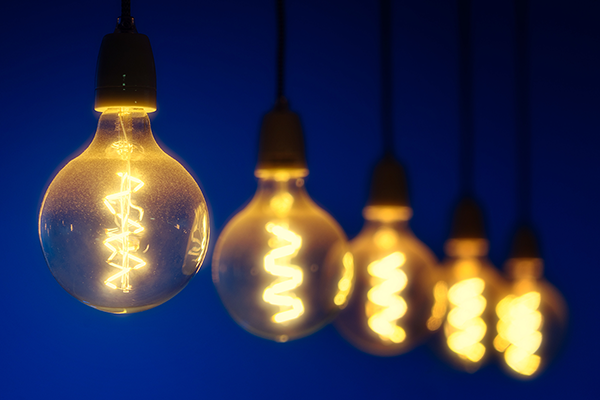
In today's rapidly evolving lighting industry, businesses are increasingly turning to LED technology for its efficiency and cost-effectiveness. The hidden expenses connected to traditional lighting systems, particularly in terms of energy use and maintenance, are a major factor driving this shift. Let's delve into these aspects to understand why LED lighting emerges as the superior choice for commercial and industrial applications.
What are the Major Deficiencies in traditional lights
Incandescent Bulbs
Inefficient energy conversion: Convert a large portion of electrical energy into heat rather than light, resulting in high energy consumption and increased cooling costs.
Short lifespan: With an average of 1000 hours, it has a short lifespan, hence it requires frequent replacements, which raises the expense of maintenance.
Limited versatility: Light is emitted in all directions, necessitating additional fixtures or reflectors to project it where needed. This makes installation more complex and raises the cost of the product.
Fluorescent Lights
Mercury content: Contain toxic mercury and phosphor, posing disposal and environmental hazards; broken bulbs release mercury vapor as well.
Sensitivity to switching: Frequent on-off cycles shorten their life span hence becoming weak over time.
Omnidirectional emission: Emit light radially through 360, needing reflectors or lenses for efficient light control hence higher system complexity and cost.
HID Lamps
High energy consumption: Compared to LED equivalents, they need more electricity per lumen produced, which raises their operating expenses.
Long warm-up times: Require a delay before reaching maximum brightness when turned on, which limits the device's applicability for uses that need illumination immediately away.
Maintenance-intensive: More likely to experience unanticipated replacements and unexpected failures, which raises maintenance costs over time.
Each such instance of routine maintenance adds up with respect to labor costs, cost of replacement parts as well as indirect productivity losses due to lighting downtime. These disruptions can have significant financial implications particularly in businesses that are running 24/7 or are situated in critical environments like hospitals or manufacturing facilities.
Advantages of LED Lighting
LEDs vs. Incandescent
LEDs consume up to 80% less energy compared to incandescent bulbs, but still produce similar amounts of light, thereby saving a considerable amount of energy bills monthly.
LEDs vs. Fluorescent
Compared to fluorescent tubes, LED tubes provide equivalent light levels with about 30% reduced energy requirements, hence provide better efficiency without compromising on quality illumination.
LEDs vs. HID Lamps
These products’ power consumption per lumen generated is significantly lower than in traditional HID lamps; this ensures longer operating hours and lower energy cost throughout the life span.
These statistics underscore the substantial energy savings potential of LED technology over traditional lighting options. For instance, transitioning a large commercial space from incandescent to LED lighting can result in immediate and significant reductions in energy consumption, translating directly into lower utility bills and enhanced sustainability efforts.
How You Can Choose the Best LEDs
Although there are multiple LEDs available in the market, IKIO offers the latest models with advanced features, ensuring superior performance and efficiency. Let’s have a look Let's examine how IKIO stands out compared to other brands.
|
Feature |
IKIO LED Light |
Other Brands |
|
Efficacy |
160 lm/W (Lineo) |
110 lm/W |
|
Lifespan (hours) |
100000 (Rodella) |
70000 |
|
Dimming Capability |
0-10V Canolux |
Limited |
|
Beam Angle |
150° x 90° (Areon) |
Fixed |
|
Photocell Function |
Integrated (Ove) |
Not Available |
Conclusion
The rationale for implementing LED lighting grows stronger as companies manage the challenges of sustainability and operating expenses; aligning with America's commitment to achieving its energy reduction and sustainability goals. By mitigating the hidden costs associated with traditional lighting—through reduced maintenance requirements and enhanced energy efficiency—LED technology offers a clear path towards long-term savings and environmental stewardship.
For American companies seeking ways forward for their lighting infrastructure, the choice to adopt LED is not just an economic one but rather it becomes an investment into sustainable growth and operational resilience.
FAQs
How do LED lights contribute to America's sustainability goals?
LED lights significantly reduce energy consumption compared to traditional bulbs, helping businesses and individuals alike contribute to national energy reduction targets and environmental sustainability efforts.
Are LED lights cost-effective for large-scale commercial installations?
Yes, LED lights offer substantial long-term savings through reduced energy bills and maintenance costs. Transitioning to LEDs in large commercial spaces can yield significant financial benefits over time.
Do LED lights require specialized fixtures for installation?
LED technology is versatile and adaptable to existing fixtures in most cases. While some retrofitting may be necessary, the long-term energy savings outweigh any initial installation costs.
What are the environmental benefits of switching to LED lighting?
LED lights have a lower carbon footprint due to reduced energy consumption and longer operational lifespans. They also eliminate hazardous materials like mercury found in traditional fluorescent bulbs, improving environmental safety.
Can LED lights improve workplace productivity?
Yes, LED lights offer superior light quality and can be tailored to provide optimal lighting conditions for different tasks and environments. Better lighting quality has been shown to enhance employee productivity and comfort in workplaces.